Apple's 2010 MacBook Air (11 & 13 inch) Thoroughly Reviewed
by Anand Lal Shimpi on October 26, 2010 10:08 PM EST- Posted in
- Mac
- Apple
- MacBook Air
- Laptops
The SSD: Not Half Bad
Apple advertises the new MacBook Air as being instant on as a result of the internal SSD. That’s mostly untrue. From a completely powered off state the MacBook Air still takes time to boot. That time is significantly reduced compared to the old MacBook Air and any other Mac with a conventional hard drive. It’s even a shorter boot than my MacBook Pro with a SandForce SF-1200 based SSD in it:
| System Performance Comparison | ||||||
| Boot | Shut Down | Sleep | Awake | |||
| 11-inch MacBook Air | 15.5 seconds | 2.2 seconds | 1.0 second | 1.63 seconds | ||
| 13-inch MacBook Air | 14.4 seconds | 1.9 seconds | 1.0 second | 1.56 seconds | ||
| 13-inch MacBook Air (Late 2008) | 34.4 seconds | 2.9 seconds | 1.6 seconds | 4.19 seconds | ||
| 15-inch MacBook Pro (SF-1200 SSD) | 19.1 seconds | 1.8 seconds | 1.5 seconds | 2.3 seconds | ||
| 15-inch MacBook Pro (Mid 2009, HDD) | 34.2 seconds | 2.8 seconds | 1.8 seconds | 2.1 seconds | ||
You'll notice that even the SF-1200 SSD in my 15-inch MacBook Pro takes longer to boot than these new Airs. Apple does customize the firmware on its SSDs. I’d be willing to bet the SSD in the MacBook Air has tight integration with OS X to guarantee quicker than normal boot times.
Clearly the new Air isn't instant on from a boot standpoint, but it's pretty much there from a recover-from-sleep standpoint. The new Airs both go to sleep and wake up from sleep quicker than any of the other Macs, including my upgraded 15-inch Core i7 MacBook Pro. Again, nothing can trump Apple's tight integration between hardware and software.
Apple likes to work with two different controller manufacturers for SSDs: Samsung and Toshiba. iFixit already confirmed Toshiba is in the new MacBook Air with its teardown:
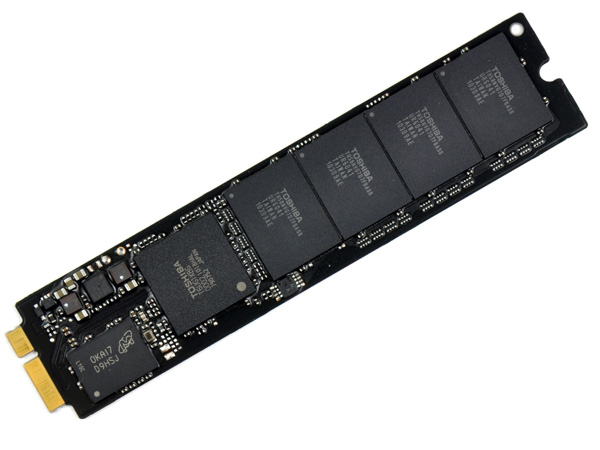
The 11-inch MacBook Air SSD, courtesy of iFixit
The SSD isn’t in an industry standard form factor, although the connector appears to be either micro or mini SATA. Presumably 3rd party SSD manufacturers (ahem, SandForce partners I’m looking at you) could produce drop in replacements for the MacBook Air SSD.
There’s nothing particularly innovative about the form factor of the SSD, other than Apple did away with the unnecessary space a 2.5” SSD would require. Just as SSDs will break the traditional SATA interface barriers, we’ll see the same happen to form factors as well.
The part number on the Toshiba controller may look familiar to some of you. It’s the same controller that’s in Kingston’s SSDNow V+ Series and the SSDNow V Series Boot Drive. I reviewed the latter not too long ago and found that it was a good drive for the money, and here’s the kicker: the SSDNow V Series Boot Drive was amazingly resilient when written to without TRIM support. Its performance hardly dropped as a result of normal desktop use. This is very important because although OS X 10.6.4 has a field for reporting TRIM support on an SSD, the instruction isn’t actually supported by the OS. Even the new MacBook Airs don’t ship with a version of OS X with TRIM support.
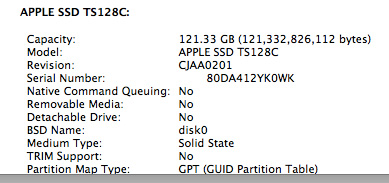
The SSD only has four NAND devices on it. Typically that would mean some very low transfer speeds, particularly on writes. But each one of those four devices has at least 16GB of NAND, spread across multiple planes and die. With the right firmware, you should be able to extract a good deal of parallelism from this architecture. Apple and Toshiba apparently do just that.

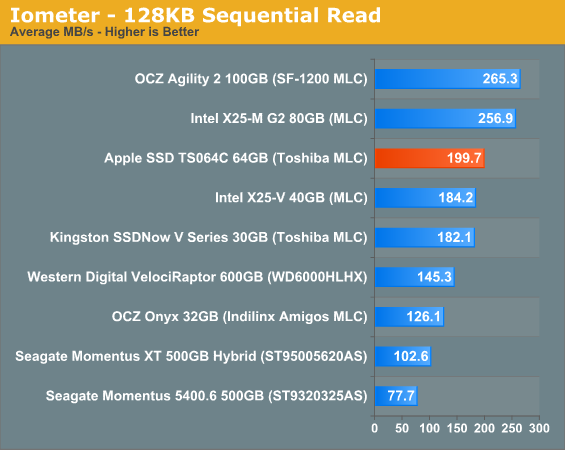
While most value SSDs top out at under 100MB/s, we get nearly 200MB/s sequential reads and writes out of the SSD in the new MacBook Air. And fortunately, Apple hasn’t only focused on sequential performance. The random read/write performance of the new MacBook Air SSD isn’t terrible:
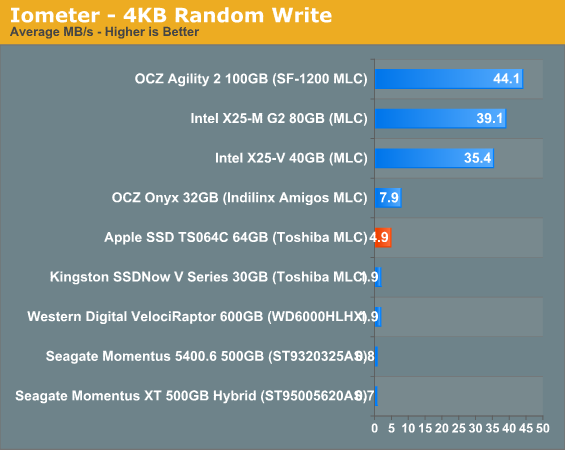
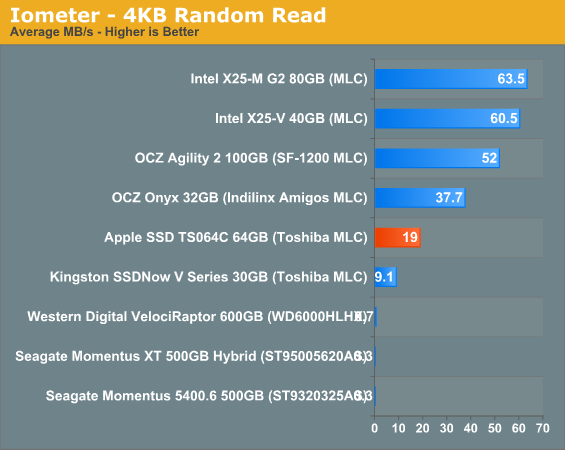
Random write performance is of course the weak point, but you’ll notice that it’s actually higher than the Kingston drive that uses the same controller. While Apple would’ve been better off striking a deal with Intel or SandForce for the controller in the MacBook Air, the Toshiba controller isn’t horrible.
As I mentioned earlier, resilience is very important as OS X still doesn’t support TRIM. I filled the drive with garbage and then tortured it for 20 minutes with random writes. The resulting performance drop was noticeable, but not unbearable:
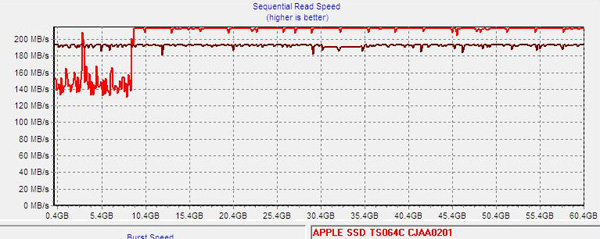
A single pass of sequential writes restores performance to normal:
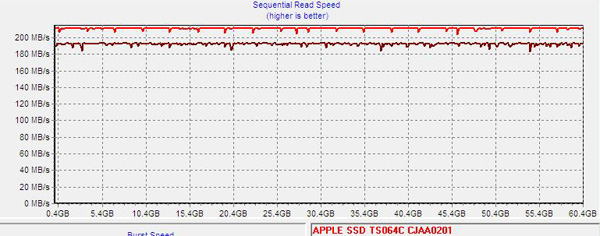
This tells us two things. First, through normal use the drive should be able to recover its performance over time (assuming you give it enough spare area). And second, if there’s any idle garbage collection in Apple’s custom firmware for the Toshiba controller it should be able to keep the drive running at peak performance even without TRIM supported in the OS. I don’t have a good way of measuring whether or not there’s GC enabled on the drive in OS X, but I suspect Apple is (at least it appears to be doing so on the Mac Pro’s SSDs).
Overall I’m pleased with Apple’s SSD selection. It could’ve been a lot better but it could’ve been a lot worse. The MacBook Airs in their default configuration have better IO performance than any other standard config Mac sold on the market today, including the Mac Pro.










185 Comments
View All Comments
solgae1784 - Wednesday, October 27, 2010 - link
Retracting my last part of my comment.....Dell XPS 15" line does have a 1080p option.Accord99 - Thursday, October 28, 2010 - link
Lenovo offers a 1920x1080 option on the T510/W510, Dell also offers it on their Studio 15, Latitude E6510 and Precision M4500 models. Asus has a number of models like the N and G which have this option, as does Sony, including the expensive 13.3" Z.Penti - Thursday, October 28, 2010 - link
Business laptops like from HP, Dell, Toshiba, Lenovo, Sony and Fujitsu has high-res screens, 13.1" 1600x900 displays, 14" 1600x900 displays, 15" 1600x900 displays and 1920x1080, and so on. (With Dell think E5510 or E6510). Those start at ~999 dollar though. But everything isn't consumer shit.ssd_trimmer - Tuesday, October 26, 2010 - link
I understand that Mac OS X does not yet support TRIM, but does the underlying SSD support it? I hope to run Fedora on a Macbook Air 13.MacTheSpoon - Tuesday, October 26, 2010 - link
As a writer, I paid a premium for my Vaio X so I could have a very light machine with all-day battery life and a bright, matte screen to use outside on sunny days. The tradeoffs have been a cramped keyboard (especially annoying for its horribly small "shift" key); a puny track pad (without two-finger scrolling, which I really miss); and a sluggish processor.I had some hope that the 11" MBA might be a viable alternative, but its lack of a matte screen, its low battery life (compared to a good netbook and certainly compared to my 12+ hour Vaio X), and even its surprisingly high weight for its battery life are keeping me from switching over, even taking into account its fantastic keyboard/track pad that I am drooling over with envy.
Furthermore, thought it's more an observation than a major purchasing reason for me, comparing the two premium netbooks I have to give the edge to the Vaio X in terms of razzle dazzle factor, too, which is sad. I really thought Apple could one-up Sony in this respect. I'm not talking visual design as much as overall "cool" factor. How cool is it that I can swap out my extended battery and have a laptop that weighs as much as an iPad but plays Flash and lets me run desktop class programs? And even its ridiculously large maximum screen angle thrills me after years of suffering from my 15" 2007 MBP; I can open up the Vaio X screen so wide that it's practically flat. It's so comfortable to sit in bed and type with it propped against my knees and its screen wide open.
Anyway, I sure would have liked the 11" MBA to equal the Sony in its battery life and weight, and to throw in a matte screen for good measure, because I knew Apple would get the keyboard and track pad right--which they did. A similarly large screen opening angle would have been great, too. Then I would have switched very, very happily. As it is, I just can't justify it. I can't give up this battery life and outdoor suitability, even if typing is somewhat irritating.
solipsism - Tuesday, October 26, 2010 - link
The Vaio X runs an Atom CPU with an Intel GM500 IGP. When running the same Light Browsing test as Anand how much time can you actually get from your Vaio X? It’s really a $1300 netbook. It’s a great machine except for CPU/GPU/RAM, but you pay a lot for it. As for weight, it’s the same weight for the Vaio X once you pay extra for the 12 hours battery (that I hear gets you about 8-9 from Light Browsing).I disagree with calling any small ultra-portable a netbook based on the display size. These came about because of the cheap, low-power and slow Atom CPUs, and built up from that was the rest of the cheap HW, with a small display and cramped keyboard. The 11” MBA is not any of those things. That CPU alone cost more than most netbooks.
Wilcomhs - Tuesday, October 26, 2010 - link
Can we have some numbers for battery life under Win 7 please? 5 hours sounds acceptable but knowing the battery life hit going from OSX to Windows would help with making a decision here.CharonPDX - Wednesday, October 27, 2010 - link
Find me one other Core 2 Duo SU9400 equipped notebook that weighs under three pounds for anywhere near this price.Find me one other Core 2 Duo SU9400 equipped notebook with anything other than Intel graphics that weighs under three pounds - for ANY price.
The 11" MacBook Air is not a netbook. Repeat that again. The 11" MacBook Air is NOT A NETBOOK. It competes in the "ultra thin/light performance notebook" segment, and it dominates it. It is lighter than almost every other notebook in its class, has the best graphics in its class, hands down (I have found a few four-pound models that have a GeForce 105M,) and it costs significantly less than anything else in its class.
The 13" model has a *LOT* more competition, because at 13", you can actually get moderate graphics and/or a decent price. But in the 11" space, the Air is all by itself.
khimera2000 - Wednesday, October 27, 2010 - link
its a netbook becaus other then web, writing, and instant messaging theres not much more you can do with it. not to mention it impimants its HDD in a similar maner as netbooks, and has no optical drive just like net books, has a weaker video card just like a netbook... this thing is a netbook, becaus theres nothing much else it can do. it fills the lower performance segmant of the notebook market, and its ultra portable which was what the netbook did.Demoure - Wednesday, October 27, 2010 - link
However, optical drives are not as important as they used to be, the video card is more powerful than that of many large notebooks sporting intel graphics, many netbooks use real hard drives, and a laptop of this power can do more than just web, writing, and messaging. It will manage to play movies, to photo editing, and low end gaming just fine, and I can't think of anything else you would want to do with a mobile device?